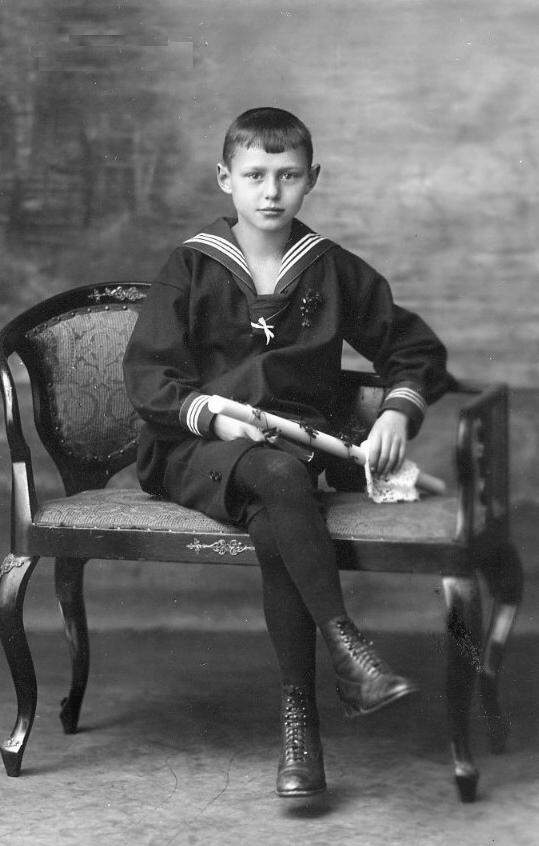
German Sailor Suits: Conventions--Specific Uses

Figure 1.--This German boy had his portrait taken for we think his confirmation. This is suggested by the white candle. He wears a traditionslly styled sailor suit with black long stokings. The portrait is undated, but looks like the 1920s or early 30s. A reader writes, "I think the early 1930s is likelier than the 1920s for the dating of this photo. I base this on the elasticity and form-fitting texture of the black long stockings, obviously cotton rather than wool. I would guess 1932-33." The age for confirmation was 13 years old.
|
|
Some information is available on the different conventions for wearing sailor suits in Germany. The sailor suit was a tremendously flexible garment. Our German archive offered numerous insights on where and when biys wore sailor suits at least during the 20th century when family snapshots become available. . We seen it being worn in all kinds of diverse circumstances. Here are some of the varied conventions for wearing sailor suits. In many cases the sane suit could be worn for different events abd circumstances. In other instances a boy might have different suits, often a new suit was reserved for good and the older suit for play. Unlike other outfits, the styling could be quite similar for both best and play. In other instances there were plainer suits for play.
Best Suit
The sailor suit could be a boy's best suit. The large number of formal portrais with boys wearing sailor suirs in the late 19th century demonstrate that the sailor suit was widely worn as a boys' best suit. Many younger boys did not have a dress suit and instead wear sailor suits. Other boys played in them.
Play Suit
The sailor suit could be an informal play garment or a boy's best suit. We know less about this usage in the late-19th century because virually all photography at the time was formal studio portraits telling only that the boys dressed up for the portraits. It is not until after the turn of the 20th century and the appearance of amateur family snapshots that we begin to see informal images showing children at play. And we see many boys wearing sailor suits for informal play. It was clearly a popular play outfit. Here a factor is that children in the ear\ly 20th-century did nit have extensive wardrobes. Thus we are not entirely sure if the sailor suits were purchased for play or were older suits that were once the boy's best suit, but now worn for play.
We see German boys wearing sailor suits on all kinds of family outings. This included walks. Where they waklked dependended on where they lived. In the city they might have gone to nearby parks. German parks were not commonly playgrounds, but well manicured green areas. More sunurban families might be able to walk into the country. This would not have been long walks when done as part of a family as mother and little sisters and brotherd could not have gone long distances. We also see picnics out in the country, although German families did not have access to cars as was common in America. This rather complicated picnicing. Of course Germany had a marvelous rail system, still handling picnic items was much more complicated when a car was not available, limiting the picnic spread. Of course the sailor suit was most popular with middle-class and ipper-class German families. And this group, especially the afflurbnt upper middle-class and upper class were the most likely to have cars.
Travel
Vacations
Schoolwear
Sailor suits were also widely worn to school, especillly in Germany. Again we have few photographs confirming this in the late 19th century. There are a wealth of family snapshots in the early 20th century showing boys going to school in sailor suits. The sailor suit declined as a school garment in tbe 1930s, in part because it was not popular with NAZI authorities.
Formal Wear
Sailor suits could also be formal wear to occasions like weddings. We note boys wearing sailor suits for chirch or other religious events such as Forst Communion or to a lesser extent Konfirmation. Here we see a boy wearing a sailor suit for his Korfirmation (figure 1), but in the inter-War era thisd begns to be less common. We see more boys wearing sack (standard) suits for Konfirmation. We alsi see boys attending ans participating in weddings, including formal wessings. We have seen quite a number of wedding images, but photographs depicting church attendance seem much less common. A studio portrait waas another event for which boys were often dressed formally. And we see countless German portraits in which the boys are dressed in sailor suits.
Religious Ceremonoes
We note German boys wearing sailor suits for formal religious events. Two of the most importaht are First Communion and Confirmation.
Choir Uniform
The sailor suit became a popular style for boys' choirs in Germany and Austria. This appears, however, to have been a development after World War I.
HBC

Navigate the Boys' Historical Clothing Web Site:
[Return to the Main German sailor suit convdntions page]
[Return to the Main country sailor suit pages]
[American]
[Denmark]
[English]
[French]
[German]
[Italian]
Other Related Pages:
[Sailor suits]
[Kilts]
[Smocks]
[Pinafores]
[Sailor Hats]
[Blouses]
[Ring Bearers]
[Long hair]
[Ringlet curls]
[Hair bows]
[Bangs]
[Collars]
[Bows]
Navigate the Boys' Historical Clothing Web Site:
[Return to clothing styles]
[Introduction]
[Activities]
[Biographies]
[Chronology]
[Cloth and textiles]
[Garments]
[Countries]
[Topics]
[Bibliographies]
[Contributions]
[FAQs]
[Glossaries]
[Images]
[Links]
[Registration]
[Tools]
[Boys' Clothing Home]
Navigate the Historic Boys' Clothing Web German pages:
[German choirs]
[German country page]
[German sailor suits]
[German school wear]
[Lederhosen]
[German youth groups]
[German royal family]
Created: 8:33 AM 9/24/2009
Last edited: 2:03 AM 3/26/2011



